- This topic has 20 replies, 13 voices, and was last updated 11 years ago by mrplow .
- 150mm forks on a Fuel EX?
I’m about to upgrade my current forks on the Trek Fuel I have. It’s an 08 version so comes with 130mm Fox RL QR. Head angle is 69 degrees BTW.
I’d like to swap to Rock-Shox Revelations, 150mm, Maxle and Blackbox.
Warranty is not an issue as it’s second hand but I want to know that it’ll be OK for the front, stress wise…
I’m hoping that I’m going to get the answer I want as my aim is to stop the dive when braking hard, this seems the answer to my woe.
Any opinions will be greatly appreciated from the STW crew, you’re a knowledgeable lot – for sure.
Cheers, Rob
Increasing the travel to 150mm is going to ruin the balance of your bike.
The correct solution is the correct forks for your bike. Luckily, you can spacer those revs down to 130mm just a treat. Then get them properly set up for you and they will be lovely.
See the “how do I stop the flappy stearing on my mega?” thread. It’ll handle like a bastard.
Please enable JavaScript

…I’m hoping that I’m going to get the answer I want as my aim is to stop the dive when braking hard, this seems the answer to my woe…
you’ll end up with 150mm of brake-dive, instead of 130mm.
‘low-speed compression damping’ is part of the answer to your woe…
Why don’t you look at a travel adjust fork so you have the 150mm for the big stuff and a more manageable 120mm for everything else. It’s what I plan on doing to my Fuel Ex.
This is the correct answer to the brake dive though.
Try to get a U-Turn Rev with the maxle and blackbox, then you can play about with the travel from 120mm to 150mm and see for yourself.
The improved damping might solve the diving issue anyway. More travel in itself won’t.
I replaced the 130 Recon Airs on my EX with 90-140 Maxle air Pikes and it transformed the bike into something a lot more stable and faster on the technical downhills* 8)
It still climbs pretty decently as well 🙂
I had to fit a longer stem (70mm I think) as I felt my torso was too far over the front after fitting the Pikes. (I’d fitted a 50mm stem when I first got the bike as the specced 90mm stem was far too long).
As for fork dive when braking hard?? Dunno what it is but I probably would if it happened.
*(mega skills compensator 😉 )
Why would you want a travel adjustable fork? That’d only mean you’d be paying more money to have the wrong fork Axle to Crown length no matter if it were extended or not?
Get something like a Talas (with adjustable travel) although i wouldn’t go over 140mm as thats what i have and i think anymore and it would ruin the bike. The adjustable travel helps a lot for when going uphill, then set it to 140mm for the downhill and its takes in the technical stuff.
I think trek had a few fuels using the talas system but from 90-130mm..
If you compared axle to crown lengths, you might be able to get a 150mm fork but not affect the axle to crown by the whole 20mm increase.
Rocksox axle to crowns are quite long for the stated travel, with recent Marzocchi’s and Fox coming in at less.
People have no issue sticking 160mm forks on 140mm frames, so why is this any different?
But as per previous posts, more travel is not definitely not the answer to brake dive.
An oil change to a thicker oil would help if you don’t have adjustable compression damping on your fork.
I don’t think 20mm will ruin the bike. I tried my 07 ex 8 with 170mm/150mm Marzocchi fork, but only a couple of rides while waiting for a new frame. It felt ok to me. perhaps obviously, 170mm was too much on anything apart from the downhill, but I liked 170mm downhill. General riding 150mm was fine, to my palate at least. I guess it depends what characteristics are important to you. Pros and cons to everything.
Thank you all – the reason I want these forks (Blackbox) is because they’ve got low speed compression, to stop dive. I’m more worried about the stress on the frame to be fair…
like i said, jumping from 130mm to 150mm – will the frame go snap?
I ran mine with 120-150 rev u-turn. Plenty of highland Munro descents and no fear about the head tube seemed pretty overbuilt in that area IMO. Dropping to 120 for climbing was a must tho handled bad in climbs at 150.
ahwiles – Member
Posted 7 hours ago #Report-Post
This is exactly what I mean, i want the new fork for the low speed my Fox doesn’t offer. Cheers.
The only issue is that it may stress the frame? Thanks to bri72 for your answer!
One thing I should of mentioned in my post above was that I had to fit a longer front brake hose to the bike as it was a fraction too short after installing the longer forks and no-one wants to celebrate a tricky, hard landing with a Dot 4 champagne shower caused by the rebound snapping the hose 😐
I’ve had a set of 15omm Sektors, a basic version of the Revs, on the front of my ’08 EX for a year, it descends a bit better, but I’d be inclined to drop the stem a little if you can to help with the fraction more wandering on the climbs.
cheers slugwash 😉
Well, the new forks are now ordered (Rev Blackbox 150mm bolt thru) and I’ll be fitting and enjoying the lack of brake dive hopefully.
Can anyone tell me that Rev’s feel better than Fox RL’s please? 😉

Like light over rocks, heavy for the brake? Is this what you mean mate?
Something like heels down, legs proper bent and you should be able to brake very hard without too much weight going through your arms and maintaining more control. So thay say on interwebs.
The topic ‘150mm forks on a Fuel EX?’ is closed to new replies.

2024 BUDGET BIKE ROUNDUP
Trek fuel ex 5 gen 5 review.
Words by Travis Reill | Photos by Dusten Ryen & Brian Niles Sponsored by Leatt & Tifosi Optics
With trail bikes in Trek’s lineup reaching five-digit prices, it is nice to see the industry giant offer a full-suspension trail bike that doesn’t break the bank. Trek was kind enough to send us the Fuel EX 5 to ride and review in our budget-bike shoot-out. At just under $2,500, the Fuel EX 5 is one of the most expensive bikes on test. We were excited to get the Fuel EX 5 out on the trails and see how it stacks up against the others in our test bike group.
• 130mm single-pivot ABP • Flip-chip adjustable geo • HTA 66.5 (high setting) • STA 75.5 (high setting) • REACH 475 (Large, high setting)
Big-brand Security
Highest Quality Frame On Test
WE DON’T
Short dropper post
Wide, Heavy wheels
Least Pedaling Support Of The Group
ABOUT THE TREK FUEL EX 5
Many of us are familiar with Trek’s trail-busting Fuel EX line. The Gen 6 Fuel EX saw added travel – not to mention a new frame design – but that doesn’t mean there isn’t room for the shorter-travel younger sibling out on the trails. With 140/130mm of travel and relatively moderate geometry, the Trek Fuel Gen 5 has been a trail bike many have reached for years.
FRAME AND FEATURES
Trek’s Fuel EX 5 features Alpha Platinum Aluminum. Trek boasts their aluminum “is continuously cold extruded and butted at multiple points, and hydroformed into sophisticated tube shapes for maximum strength and minimum weight.” The Fuel EX also has Trek’s Knock Block headset system, which prevents the handlebars from hitting the top tube and causing damage in a crash. Cables are internally routed, and the frame is offered in two color options: black, or the black and yellow we received.
The Fuel EX is offered in seven sizes, from XS to XL. X-small and small frame sizes come with 27.5-inch wheels and a pronounced dip in the top tube to help with standover height. Sizes medium and up are all equipped with 29-inch wheels. If you are familiar with Trek’s sizing, you will know that they also offer a medium/large size for those in between the two sizes. This is the only “in-between” size offered.
Trek’s Mino Link allows you to change the Fuel EX’s geometry. Switching from high to low will slacken the bike by 0.5°, drop the BB by 6mm, and shorten the reach by 5mm. While the bike comes with a 140mm travel fork, Trek gives allowance for bumping up to 150mm to improve descending capability.
The Fuel EX is essentially a linkage-driven single-pivot with one key difference—a pivot at the rear axle. Trek calls this their Active Braking Pivot (ABP) design. On most suspension designs, braking is considered to negatively impact the rear suspension’s ability to absorb impacts and provide traction. Trek’s ABP design aims to allow the rear suspension to remain more active under braking forces.
The Fuel EX 5’s geometry remains relatively moderate compared to today’s trail bike trends. For clarity’s sake, I’ll share the geometry in the “high” setting of the geometry-adjusting Flip Chip. The head tube angle is 66.5° and is paired with a 75.5° seat tube angle. The Stack Height ranges from 559mm to 623mm and Reach lengths range from 400mm to 500mm. Our size large came in at 609mm and 475mm respectively..
The BB height is 341mm in X-small and small, then 346mm for medium and up. Similarly, the BB drop is only 14mm below the axles on the two smallest sizes, and 28mm on sizes medium and up to account for the larger wheels. 436mm chainstays feature across all sizes. Our size Large Wheelbase totalled 1211mm.
BUILD SPECS
For the Fuel EX 5, Trek only offers two build options: a higher-end, 9.8 AXS Gen 5 and the budget-friendly EX 5 they sent us at $2,499. Leading the charge on our test bike was a Rockshox Recon Silver with the Motion Control damper and lockout. In the rear, there was a X-Fusion Pro 2 shock with “open” and “climb” positions.
The drivetrain is a complete Shimano Deore M6100 12-speed build, with Shimano’s 10-51 tooth cassette and a 30-tooth chainring. Shimano also handles the brakes, with 2-caliper hydraulic stoppers and 180mm rotors. 35mm width Alex MD35 wheels are laced to Bontrager hubs, and roll on wide 2.6 Maxxis Rekons. Bontrager makes up the rest of the build with tires, cockpit, and saddle—with the exception of a TranzX dropper post at a short 130mm drop length.
With a brand name as large as Trek, our expectations with the Fuel EX 5 were reasonably high. Even with a more budget-friendly component build, we figured Trek’s proven platform would shine through, regardless of the parts hanging from the frame.
When we tested the Trek Fuel EX 5 on the trails, we found it best suited for riders looking to put in miles. Its very moderate 66.5° headtube angle—the steepest of any of the bikes on test—puts the rider’s body more toward the front of the bike. This allows for a comfortable pedaling position, especially on climbs, which the Fuel EX 5 did reasonably well on. That forward-heavy position also provided good handling on the relatively techy bits of the climbs.
Even with a steeper headtube angle, the Fuel EX 5 wasn’t overly twitchy on faster descents. With 130mm of rear travel, it tackled some rough and chunky trails reasonably well, but finding its limit was quite easy for our aggressive riding crew. It also jumped decently, although the suspension had been firmed up quite a bit. This was done out of necessity, to add support to prevent harsh bottoming out on harder hits. Less aggressive riders looking for a more conventional light-duty trail bike may not feel the need to do the same.
One thing that seemed to hold the Trek Fuel EX 5 back while descending was the dropper post. Our size large EX 5 came with a 130mm dropper, a much shorter length than we’re used to for a size large frame. This meant having quite a bit less post insertion to get proper saddle height for climbing. When it was time to point the EX 5 downhill, the seat, even when dropped all the way down, was high enough between your legs to make handling the bike uncomfortable.
Initially, the expectation was that the Trek Fuel EX 5 might be the most efficient and best pedaling bike on test. However, we found that this wasn’t the case once we hit the trails. The bike’s geometry teased that as the case, but something seemed to be holding it back. After several of our testers spent considerable time on the Fuel EX, we concluded that the rolling weight of the wheels made the bike seem sluggish. We’re not sure why a trail bike is spec’d with 35mm inner width rims, but that, combined with 2.6 width tires, surely hurt the Trek’s performance when it came to rotational efficiency.
As with many of the other budget bikes in the field, the suspension and brakes were also where the Trek Fuel EX 5 came up short. The Fuel EX 5 shared the same suspension, and many of the same issues, as the GT Sensor Sport. The fork and shock both seemed sticky, and there were very few adjustments. The air pressure X-Fusion recommended for me (Travis) essentially turned the bike into a hardtail. When I let air out to get an appropriate SAG, the shock bottomed out hopping off a curb. Regarding brakes, the Shimano 2-pistons performed better than some of the other brakes on the budget bikes, but they still left us wanting a bit more power.
The Wolf’s Last Word
Price: $2,499.99 Website: Trekbikes.com
2024 BUDGET BIKE SHOOTOUT SPONSORS
Leave a comment, win free swag.
Want to win some free schwag? Leave a comment and vote up the most thoughtful comments and each month we’ll pick a winner. The person with the smartest and most helpful replies will earn some sweet new gear. Join the Pack and get the latest news and read the latest reviews on the top mountain and electric mountain bikes .
Gear-obsessed editors choose every product we review. We may earn commission if you buy from a link. How we test gear.
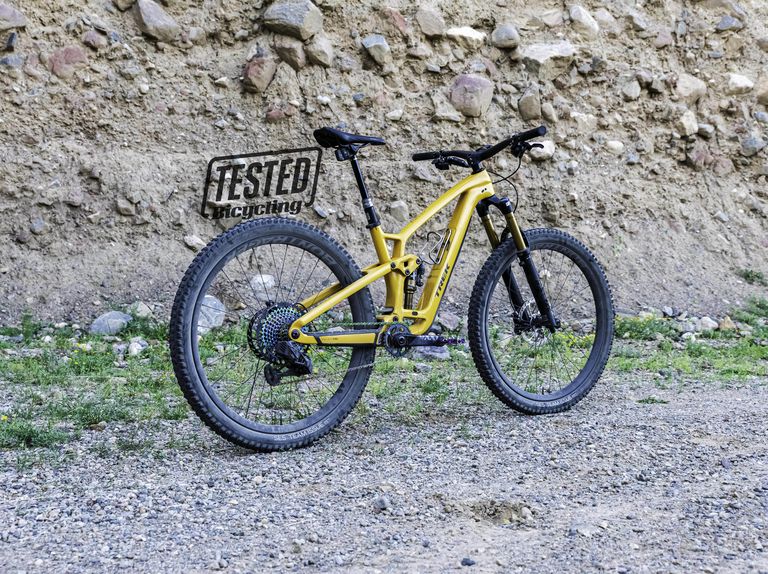
The New Trek Fuel EX Puts On Weight, Punches Harder, and Expands Its Reach
Trek's new Fuel EX is bigger, more capable, and more adjustable
The Takeaway: The new EX is bigger and more capable. It faces tougher competition, but its performance, features, and adaptability make it a compelling option.
- 10mm more travel: now 140mm rear and a 150mm fork
- Two different geometry adjustments, plus adjustable shock rate
- Most aluminum frames now get internal storage
- Eight builds with the new platform starting at $3,700
Price: $2,700 to $10,750. As tested $10,750 (EX 9.9 XX1 AXS) Weight: 30.2 lb. to 35.2 lb. (claimed. 31.2 lb. as tested (EX 9.9 XX1 AXS, size medium)
Trek tries to cover a lot of ground with this one bike, which is why it has so many features and adjustments, plus a wide range of models and sizes. By trying to do so much with one bike, I worried that in making a bike to satisfy everyone, Trek made a bike that satisfies no one. After riding it I don’t think that’s the case. It’s no Holy Grail, but it is a fine machine for many riders, and a variety of terrain.
Trek Fuel EX Gallery
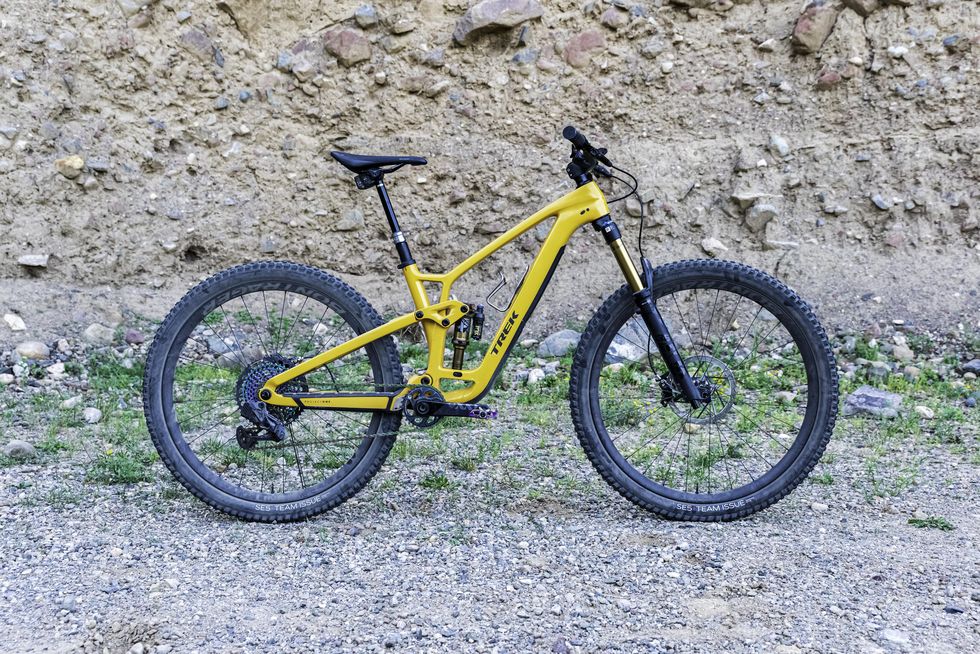
Trek Fuel EX—Builds, Prices, and Weights
The new Fuel EX launches with eight stock builds (three aluminum models and five carbon). The least expensive model, Fuel EX 5, uses the old frame platform (130mm rear travel with 140mm fork), while the rest use the new 140/150mm platform. Prices start at $2,700 for the EX 5 and top out at $10,750 for the EX 9.9 XX1 AXS.
Claimed frame weights are 3.4kg (7.5 lb.) for the carbon frame and 4.6kg (10.1lb.) for the aluminum frame. Complete bike weights start at 13.71kg (30.2lb) for the 9.9 XTR and go up to 15.96kg (35.2lb).
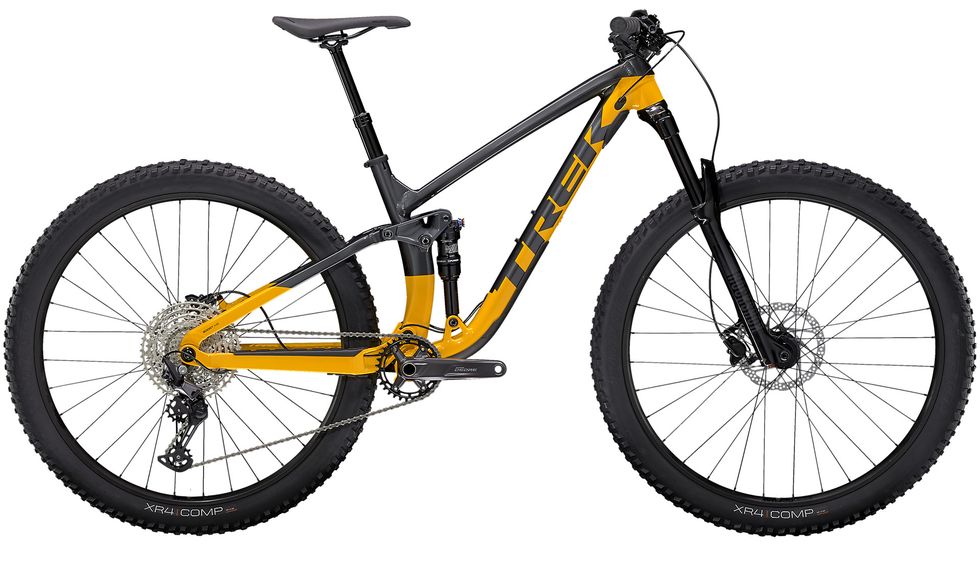
If you’re not feeling the stock options, the Fuel EX will drop into Trek’s Project One customization program (eventually) if you want to pick your paint and parts.
Trek Fuel EX – What’s New
Comparing the previous generation Fuel EX to this one, it is obvious this bike isn’t a mid-cycle refresh but a ground-up redesign of the brand’s mid-travel trail bike.
Outwardly, the Fuel EX displays a new frame design direction for Trek. First seen on the sibling EX-e electric bike , the new frame is more swole, with additional trusses linking the top tube to the seat tube and the seat tube to the down tube.
Part of the reason for the stouter-looking frame is a 10mm bump in travel at both ends: The rear increases to 140mm, paired with a 150mm fork. An additional change to the suspension is a two-position leverage-rate flip chip which offers a more and a less progressive setting. This is much easier than swapping volume spacers inside an air shock and also (in the more progressive position) makes the EX compatible with coil-spring shocks for the first time. But note that changing the leverage rate on the shock affects the spring and damper while changing volume spacers affects only the spring.
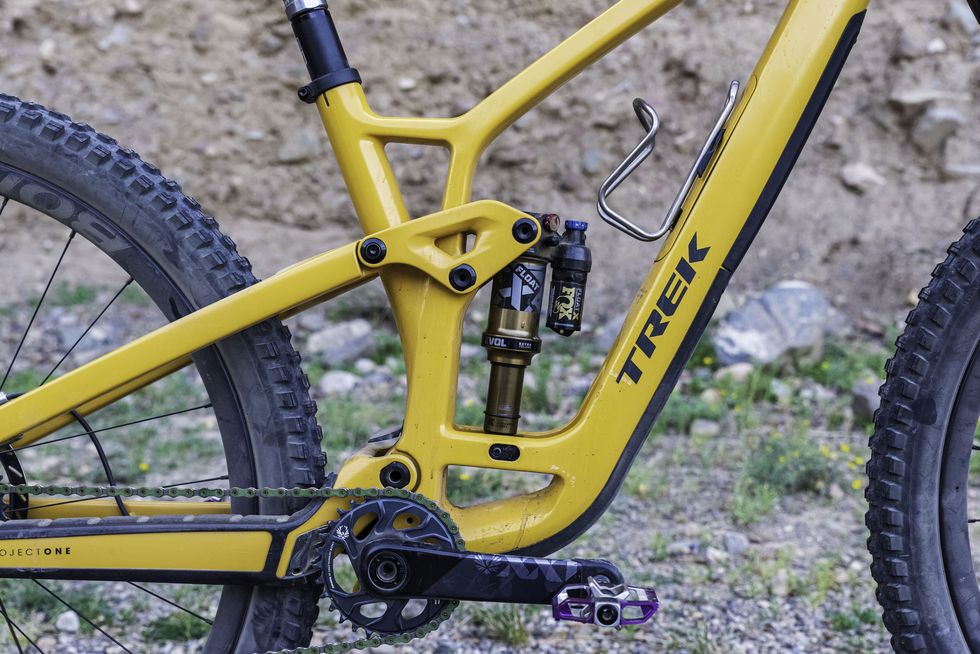
Trek also approved most of the new EX frames for the stouter RockShox Zeb and Fox 38 forks in up to 160mm travel.
With the bump in travel, the EX features revised geometry. The TL;DR: A 10 to 20mm longer reach, 1.5-degree slacker head tube angle, about a two-degree steeper seat tube angle, and size-specific chainstay lengths. As before, the EX has Trek’s two-position Mino Link in the rocker (which alters head and seat angles and BB drop.) New to the party are angle-adjusting headset cups which offer three head angle possibilities with no effect on bottom bracket drop/height. And if you like your wheel sizes mixed, the new EX is rated for that too.
The seat tube sees revisions that help it fit longer-travel dropper posts, and the post diameter was bumped up to 34.9mm. Your mileage may vary, but I’ve found the 34.9mm droppers operate more smoothly and are less likely to bind than 31.6 or 30.9mm droppers.
Trek added full-length guides to the EX’s internal routing to make assembly and maintenance easier, plus they can’t slap around in the downtube anymore. The guides also mean the hoses and hosing don’t interfere when you’re stuffing the repair kit burrito into the EX’s downtube. And talking of that downtube storage, it’s now built into the aluminum frames, in addition to the carbon.
The bottom bracket shell is now threaded, and there is a whole mess of plastic bolted to the downtube for impact and shuttle protection. Features carried over from the previous generation include Trek’s ABP suspension system, ISCG ’05 tabs, and the Mino Link flip chip in the rocker link.
Trek Fuel EX—No More Proprietary Shocks
One of the less conspicuous (but very significant) changes to the new EX is the adoption of a stock shock. Gone is the Thru Shaft design —which required a screw-in lower extender for the shock shaft—and the regressive Re:Activ damper tune . In its place is a standard shock, although it is custom-tuned for the frame (a step that all reputable brands take).
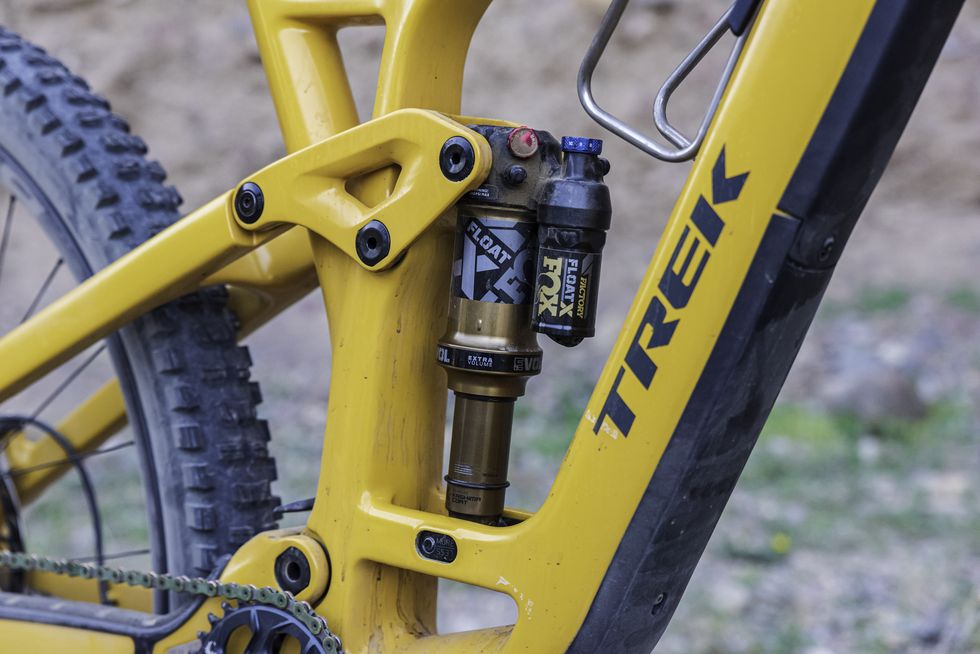
Abandoning suspension features has been somewhat of a theme for the Fuel EX. Follow the progression of EX since its debut in 2005, and you will see Trek adding new rear suspension technologies only to remove them for later iterations. This includes Full Floater (dynamic upper and lower shock mounts), DRCV (dual rate control valve) shocks (some EX forks had DRCV also), RE:Activ, and Thru Shaft. If you add in other since-abandoned features like Knock Block (a stop which limited handlebar rotation), and Press Fit 92 bottom brackets, previous generation EXs are a boneyard of forsaken technologies.
Why are Thru Shaft and Re:Aktiv gone? I asked Trek that question and am yet to receive a response. I sense that Trek will say the same thing they said when I asked why they eliminated Full Floater from the 2020 Fuel EX : That the newest generation of shocks (like Fox‘s Float X ) make those proprietary technologies redundant.
The benefit to the rider is the new Fuel EX uses a standard trunnion mounted shock, which means they can choose to ride a wide variety of options. Trek says they’ve confirmed fitment of all Fox, RockShox, and DVO air and coil shocks. Plus, it fits the Push ElevenSix and EXT’s Storia coil.
Trek Fuel EX—Updated Geometry, More Adjustments, Mullet Compatible
As previously mentioned, the Fuel EX receives all-new geometry. And it gets expanded geometry adjustment options. There are now two geometry adjustments: Head tube angle cups (three options: zero, plus-one degree, minus-one degree), and Mino Link (two positions: alters head and seat angles +/- 0.5 degrees and bb height +/- 8mm). That results in six configurations in total.
There are seven frame sizes (extra small, small, medium, medium/large, large, extra-large, and double-extra-large) in aluminum and six in carbon (no double-extra-large). And the EX now has size-specific chain stay lengths and seat tube angles. And the extra small and small come with 27.5-inch wheels, while the rest come with 29-inch wheels (size small is available with either 29" or 27.5" wheels.) AND Trek made the EX (with 29" wheels) compatible with mixed wheel sizes, but when running a 27.5 rear wheel, Trek recommends 160mm fork travel (10mm more than stock) and putting the Mino Link in high mode.
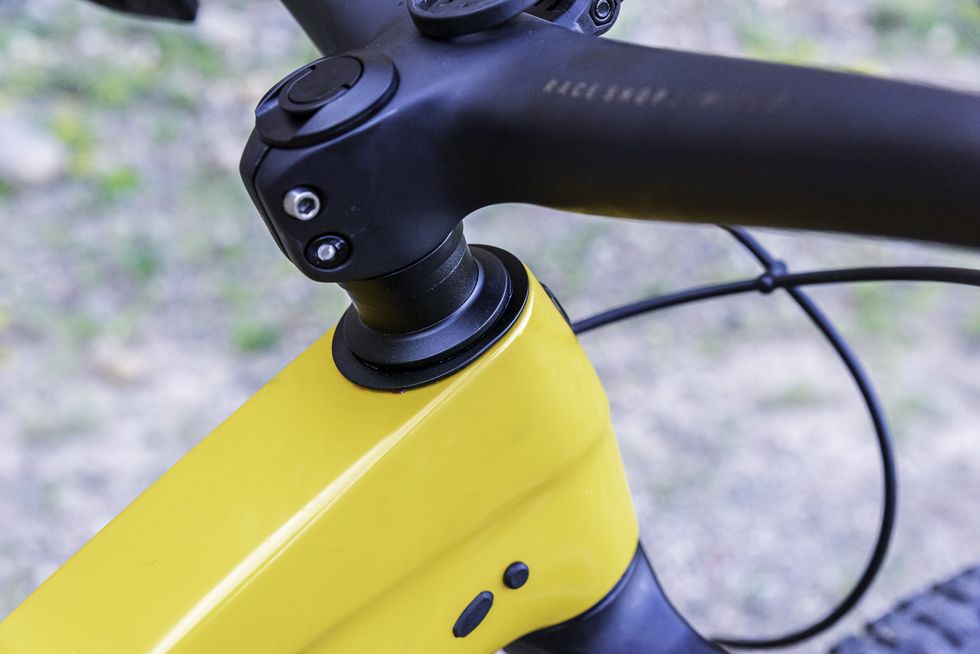
Is it any wonder that Trek has a dynamic geometry tool on its website to help you parse all the different configurations?
All this makes comparing the geometry to the previous EX difficult, but to get a flavor of the changes, I’ll compare the old size large to a new size large. With both in “stock” geometry configuration (Mino Link in low for both, the new frame with the neutral headset cup), the new bike measures up as follows:
Reach - 15mm longer (485 vs. 470mm) Stack - about eight millimeters taller (621.3 vs. 613mm) Effective seat angle - 2.5 degrees steeper (77.2 vs. 75 degrees) Head angle - 1.5 degrees slacker (64.5 vs. 66 degrees) Trail - almost 10mm longer (129.3 vs. 119mm) Chainstays - three millimeters longer (440 vs. 437mm) Wheelbase - almost 40 millimeters longer (1250.2 vs. 1211mm)
I’m not going to bother pasting the nine different geometry charts Trek sent me into this story (because that would be ridiculous.) The stock head angle is 64.5 degrees: If you want to nerd out on the rest of the numbers, dial-up Trek’s geometry tool and dig in.

Trek Fuel EX—Ride Review
The biggest mistake I made during my first rides on the new EX was comparing it to the outgoing 130/140mm EX. I loved the previous generation , and I liked its somewhat unique positioning between 120mm trail bikes like Evil’s Following and bigger trail bikes like the Pivot Switchblade.
But the new EX is not the old EX: It’s a bigger and more capable bike. It can be ridden harder and in rowdier terrain. But because it is heavier, longer, slacker, and has more travel, the new bike doesn’t feel as snappy as the outgoing bike. And it doesn’t feel as crisp on the climbs either. If you’re looking for a trail bike more like the old EX, the closest you’ll get in Trek’s current line is a Top Fuel with a 130mm fork upgrade.
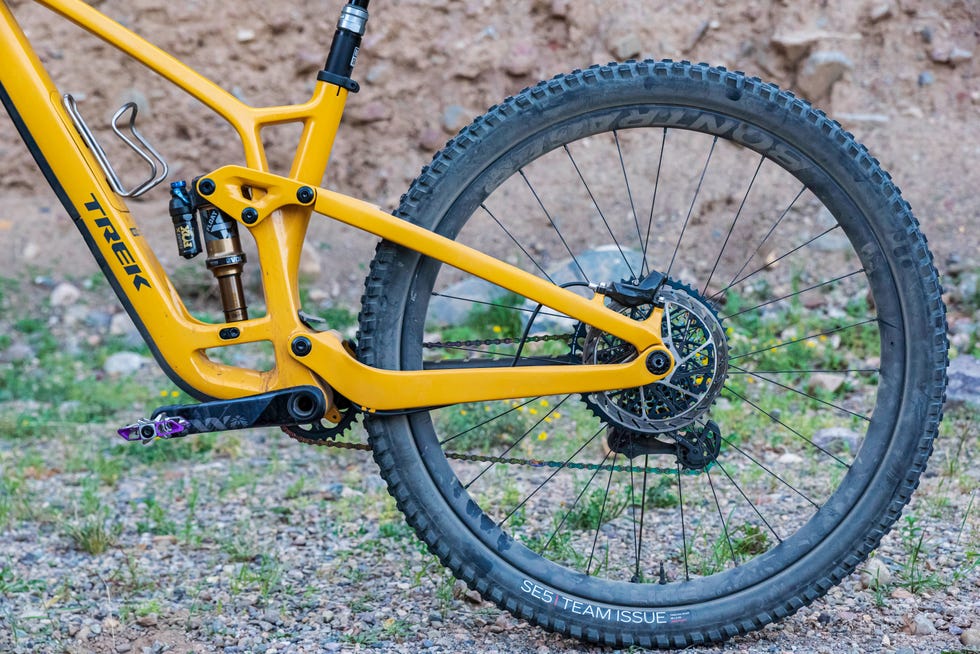
Once I got my head straight about what the EX was all about, I began to groove with it. The Fuel EX is an excellent trail bike. Well, I have one complaint. I was getting some noise from the front end. I solved this by pulling the entire headset assembly, cleaning, greasing, and reinstalling it—chuckling to myself the whole time because Trek’s product team said they designed the system the way they did because they found competitors' adjustable head angle systems were noisy.
With six possible geometry settings—nine if I fitted a 27.5 rear wheel, which I, so far, have not—there wasn’t time to evaluate them all adequately before today’s launch. So, I’ve done all my rides on the EX in the stock setting (Mino Link in low, headset in the neutral position). And in that setting, the EX is a well-rounded trail bike.
I did my first ride on the EX in Whistler, British Columbia where I ground up the steep climbs and then pointed down tight, rough, and frequently very steep and technical trails that dot the landscape. The EX held its own, offering a comfortable climbing position and an efficient and supportive pedaling platform on the climbs. On the descents, it was reassuring; equal parts precise and confidence-inspiring. I decided to run the shock rate in the progressive position for this ride and was happy I did as the rear end returned suppleness with plenty of support and bottom-out resistance.
I expect some riders will find the EX, even with its new and more muscular body, is not quite enough bike for Whistler-style riding, which I can understand. But it can hold its own while the old EX would be out of its element.
I got the rest of my rides on the new EX in Durango, Colorado. Compared to B.C. riding, the climbs in Durango typically aren’t as steep, and the descents are faster, more open, and not as consistently technical, but the altitude is much higher. The EX felt a bit more in its sweet spot here, and I used the less progressive shock rate, which gave me a deeper-feeling suspension. With the lightest EX coming in at over 30 pounds, I’m not going to say I’m thrilled to hammer out a multi-hour singletrack climb at five-figure altitudes on this bike. It is efficient and accurate enough on climbs that I will ride it up because the payoff on the descents is so worthwhile.

I can’t say that I found any one thing, or things, in my testing of the EX so far that rocked my world. It seems to do everything it is supposed to do well. It’s appropriately stiff and feels solid, the suspension works well over a wide range of situations, and the pedaling and braking performance is good also. Performance-wise, it seems to be in the same ballpark as the other good trail bikes of similar travel I’ve ridden.
But I think this EX will be a slow burn. A bike I enjoy more and more as I spend additional time on it. I have no science to back that feeling up, just a gut sensation based on years and years of testing bikes. I have experienced other bikes sneak up on me and become a favorite after being lukewarm about them at first. And I do love how much Trek built into this bike: There’s a ton going on with it when you dig into the details, and much of it will help riders dial in the bike better for their conditions and preferences. In the long run, this should make the new EX easier with which to live.
Sometimes it’s the quiet ones that are the most special.

A gear editor for his entire career, Matt’s journey to becoming a leading cycling tech journalist started in 1995, and he’s been at it ever since; likely riding more cycling equipment than anyone on the planet along the way. Previous to his time with Bicycling , Matt worked in bike shops as a service manager, mechanic, and sales person. Based in Durango, Colorado, he enjoys riding and testing any and all kinds of bikes, so you’re just as likely to see him on a road bike dressed in Lycra at a Tuesday night worlds ride as you are to find him dressed in a full face helmet and pads riding a bike park on an enduro bike. He doesn’t race often, but he’s game for anything; having entered road races, criteriums, trials competitions, dual slalom, downhill races, enduros, stage races, short track, time trials, and gran fondos. Next up on his to-do list: a multi day bikepacking trip, and an e-bike race.

.css-1t6om3g:before{width:1.75rem;height:1.75rem;margin:0 0.625rem -0.125rem 0;content:'';display:inline-block;-webkit-background-size:1.25rem;background-size:1.25rem;background-color:#F8D811;color:#000;background-repeat:no-repeat;-webkit-background-position:center;background-position:center;}.loaded .css-1t6om3g:before{background-image:url(/_assets/design-tokens/bicycling/static/images/chevron-design-element.c42d609.svg);} Member Exclusive

The Best Century Rides Across the U.S.

How to Make Your Bike Commute Better

How to Conquer Long Slow Distance Training

Start Riding a Bike Again After Having a Baby

How to Handle These 7 Tricky Group Ride Situations

What Muscles Do You Work on a Bike Ride?

A Coal-Rolling Crash That Nearly Killed 6 Cyclists

Tested: BlackHeart's Gravel AL

How to Know if That Second-Hand Bike Will Fit You

15 Beginner Cycling Questions—Answered

Indoor vs Outdoor Cycling: How They Compare

Based on frame geometry and build specs.
A bike with lower gearing will be easier to ride up steep hills, while a higher top end means it will pedal faster down hills.
2023 Fuel EX 7 Gen 6
2024 Fuel EX 8 GX AXS T-Type Gen 6
2023 Top Fuel 7
(descending)
Based on build material and quality level of the frame, fork, wheelset, groupset, suspension system, and more.

- Forum Listing
- Marketplace
- Advanced Search
- Mountain Bike Manufacturer Forums
- Bike Manufacturers
Trek fuel ex 5 vs. Scott spark 960
- Add to quote
Tried finding a comparison for these two bike, but not a lot out there for the Scott (mostly others in the spark line). Hoping to buy one of these within the next few days, but am not sure which is the better bet. The trek is $1800 while the Scott is listed at $1900, but up until this weekend is at $1600. Just getting back into riding and am not really sure on which has the better components, and which I'll end up upgrading. Thanks,
If you are just getting back into riding, start with the Scott. It has less (more manageable) suspension travel, and if it costs less, then if it fits it will be your best choice.
IMO, don't waste your money with an EX5. It's such a baseline entry into the FS that it's not worth it. Go at least an EX6 and up.. As for Scott, couldn't tell you. Been seeing them more and more. I am considering one as my next bike. I demo'd a FS carbon model and loved it.
- ?
- 15.5M posts
- 518.2K members
Top Contributors this Month
We'll take care of you. Period.
It's our mission to provide you with world-class hospitality every time you visit us online or in-store. We're always here to help you. It's the Trek way.
Free shipping and professional assembly
All bikes ordered online ship for free to your local Trek shop for professional assembly. Participating retailers will even deliver your new ride to your doorstep!
30 Day Unconditional Guarantee
If for any reason you aren't 100% happy with your trekbikes.com purchase, you can return it in like new condition within 30 days - no questions asked.

"I'm stoked"
"I think it's the best looking bike in it's price range, the fit works great for me, and the drivetrain is excellent."

"Ready to rumble"
"Has the chops to squeeze every last drop of fun from local park trails, plus the talent to conquer black diamond terrain on the weekends."

"Much more capable downhill than I would have ever imagined; then, when I finished a lap and turned around to pedal back up, I was pleasantly surprised by the comfort and efficiency of the Roscoe’s climbing position."
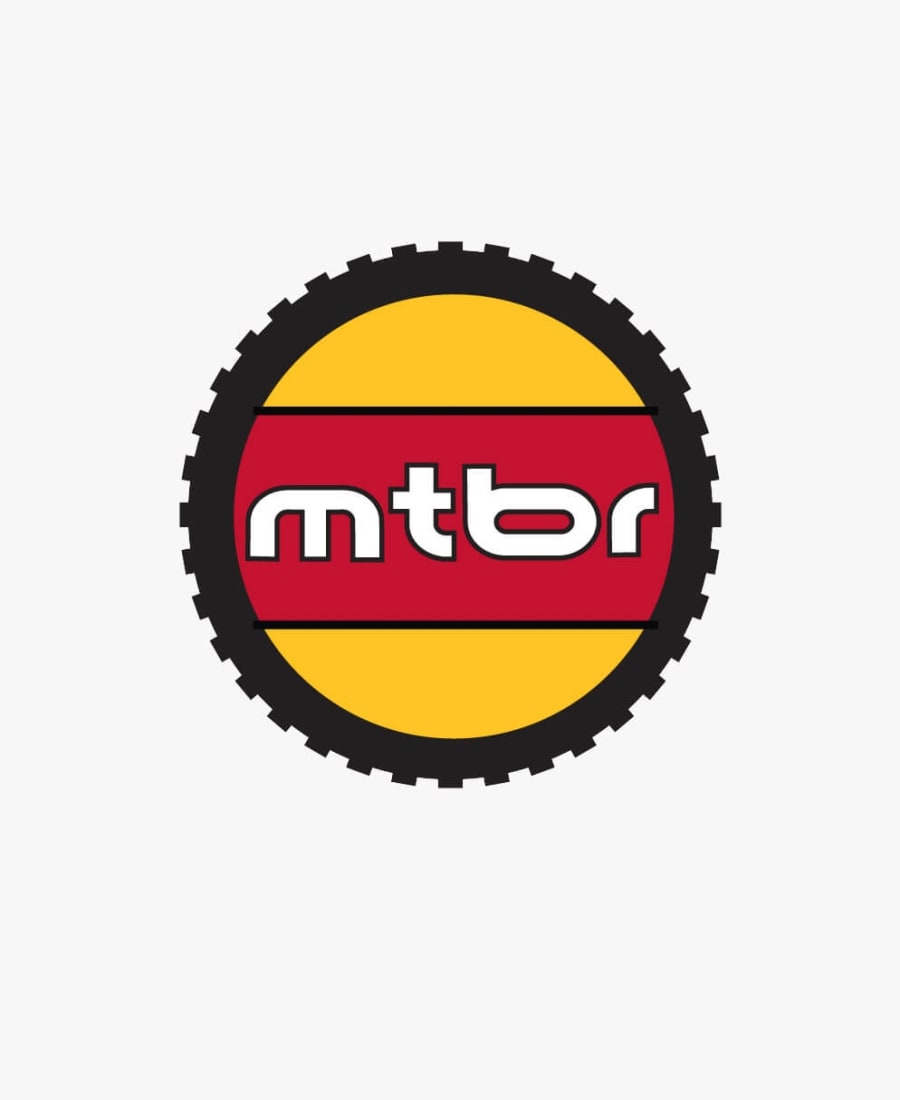
"5 out of 5"
"One of the best we've ever tried at this price. So fun and capable it makes boring trails interesting and difficult trails manageable. "
More options

IMAGES
VIDEO
COMMENTS
BassistBiker Discussion starter. 255 posts · Joined 2018. #1 · Aug 17, 2020. So, as the title says, I'm hoping to swap a 150mm fork onto my Fuel EX 8...I have an opportunity to grab a Pike Ultimate for a silly great price from a friend, but I have ?'s. I checked on the Trek webpage, and the Fuel frame will take up to a 150mm fork, so that's fine.
Gravity trails are Red and Black. Now down to the problem, I am looking over 3 2021 models of forks but I am very puzzled which one should provide the needed support. - RockShox Yari RC DebonAir Boost 29" Suspension Fork - 2021 Model - 150mm travel 42mm offset. - RockShox Pike Select RC DebonAir Boost 29" Suspension Fork - 2021 Model - 150mm ...
A Fuel EX with 150mm will not ride the same as a Remedy. If riding the same trail side by side that 150mm + of travel is preferred , pretty much any rider would choose the Remedy. Obviously having a fork with adjustable travel is different. If its set at 140mm but capable of 160mm, since its set within tolerance, not a problem.
2020 Fuel EX 8 with 150mm fork or Slash 8 with 150mm fork. This is something I have been contemplating. I currently own a 2018 Fuel EX 9.8 with 140mm fork (150mm didn't feel right) and I modded the rear shock to 210x55mm giving me a bit more travel. My current Fuel EX is a great bike, but having recently moved somewhere where trails are a lot ...
August 15, 2012 - Hi All, I'm about to upgrade my current forks on the Trek Fuel I have. It's an 08 version so comes with 130mm Fox RL QR. ... I tried my 07 ex 8 with 170mm/150mm Marzocchi fork ...
For the Fuel EX 5, Trek only offers two build options: a higher-end, 9.8 AXS Gen 5 and the budget-friendly EX 5 they sent us at $2,499. Leading the charge on our test bike was a Rockshox Recon Silver with the Motion Control damper and lockout. In the rear, there was a X-Fusion Pro 2 shock with "open" and "climb" positions.
Trek's also given it a 10mm bump of travel on both ends to 140mm and 150mm, making it the biggest Fuel EX ever and also the first that'll work with a coil-sprung shock.
Trek completely redesigned Fuel EX models for 2023, updating the geometry and suspension while adding a ton of adjustability. The big wheel trail bike still falls squarely in the mid-travel category with 140mm of rear suspension and a 150mm fork, but it's longer, more capable, and more adjustable than ever.
The least expensive model, Fuel EX 5, uses the old frame platform (130mm rear travel with 140mm fork), while the rest use the new 140/150mm platform. Prices start at $2,700 for the EX 5 and top ...
Fuel EX 5 Gen 5. $2,199.99 $2,699.99. Model 5260692. Retailer prices may vary depending on location and delivery method. The final price will be shown in your cart. Fuel EX 5 is a full-suspension trail bike that's ready to handle it all. With trail-taming 140mm front and 130mm rear suspension, a Shimano 1x12 drivetrain, a dropper post for ...
Discover your next great ride with Fuel EX 7 NX. See the bike and visit your local Trek retailer. Shop now! ... Max compatible fork travel: 150mm (561mm axle-to-crown) *Wheel front: Size: XS , S Bontrager Line Comp 30, Tubeless Ready, 6-bolt, Boost110, 15mm thru axle, 27.5''
A Fuel EX with 150mm will not ride the same as a Remedy. If riding the same trail side by side that 150mm + of travel is preferred , pretty much any rider would choose the Remedy. Obviously having a fork with adjustable travel is different. If its set at 140mm but capable of 160mm, since its set within tolerance, not a problem.
Fuel EX 7 Gen 6. 18 Reviews / Write a Review. $2,999.99 $3,699.99. Model 5271995. Retailer prices may vary depending on location and delivery method. The final price will be shown in your cart. Fuel EX 7 is a do-anything trail machine evolved to eat up singletrack. Upgraded 150mm front and 140mm rear suspension smooth out rough and technical ...
It will slacken the bike about .5° for the head angle. I'll be running a 160mm fork on mine this year. It's a very affordable upgrade as you only need to change the air shaft. In Canada an air shaft is about $90 the last time I bought one. A shop will charge around $70-100 to install.
The Trek Fuel EX 7 Gen 6, Trek Fuel EX 8 GX AXS T-Type Gen 6, and Trek Top Fuel 7 are all aluminum frame full suspension trail bikes. ... The Fuel EX 8 GX AXS T-Type Gen 6 has better components and a better fork, while the Top Fuel 7 has 29″ aluminum wheels. ... lockout, tapered steerer, 44mm offset, Boost110, 15mm Maxle Stealth, 150mm travel.
Fuel EX Gen 6. With 140mm rear and 150mm front travel, Fuel EX Gen 6 gives you extra adjustability features and more stable handling, plus a more robust frame with internal storage on all models, including alloy. • 140/150mm travel • More stable handling • More robust frame • More adjustability • Internal storage on all models. Shop ...
A Fuel EX with 150mm will not ride the same as a Remedy. If riding the same trail side by side that 150mm + of travel is preferred , pretty much any rider would choose the Remedy. Obviously having a fork with adjustable travel is different. If its set at 140mm but capable of 160mm, since its set within tolerance, not a problem.
I got the full suspension mountain bike last summer and road it once no scratches or wears it has a dropper post upgraded race face pedals shimano deore shifting system rock shock air/adjustable fork 140mm of travel and the X fusion pro air/adjustable rear suspension and has shimano mineral oil disc brakes the bike frame is a size L
Fuel EX with 150mm fork. Jump to Latest Follow REVIEWS DEALS BIKESHOPS TRAILS 61 - 78 of 78 Posts. 1 4 of 4 Go to page ... my setup is a Trek Fuel EX 8 2021 XT. I contacted Trek, and 150mm travel or 561mm axle-to-crown is the max recommended fork for the Fuel EX. thread necromancy completed -
Model 5260202. Retailer prices may vary depending on location and delivery method. The final price will be shown in your cart. Roscoe 6 is the ideal gateway to mountain biking for new riders looking to have a fun time on the trail. It has plus-sized tires that inspire confidence by elevating traction, a suspension fork that soaks up the big ...
Hey Mitch@Trek I've just picked up a Fuel EX 9.8 and before I get going on planned upgrades I'm keen to know if you can run a 150mm fork on this bike? It has been suggested in a few forums, but I can't find a clear yes or no. Expecting that if I upgrade the damper and go 150, that I'd need to keep the frame in steep mode. Cheers
Trek fuel ex 5 vs. Scott spark 960. Tried finding a comparison for these two bike, but not a lot out there for the Scott (mostly others in the spark line). Hoping to buy one of these within the next few days, but am not sure which is the better bet. The trek is $1800 while the Scott is listed at $1900, but up until this weekend is at $1600.
Roscoe 7. 38 Reviews / Write a Review. $1,399.99 $1,899.99. Model 5260351. Retailer prices may vary depending on location and delivery method. The final price will be shown in your cart. Roscoe 7 is a hardtail for riders who are ready to cut loose and have a blast ripping up the trail. A plush 140mm suspension fork, 29er wheels, and a wide ...